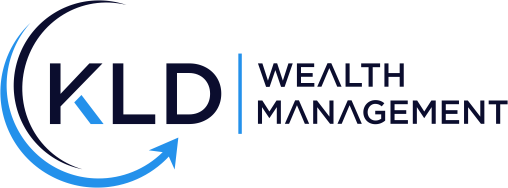Get in touch
Call or Text:
937-404-5180
Email:
dwiedmeyer@kldwealth.com
Smart Strategies for Tax Planning in Retirement: Maximizing Your Savings and Minimizing Your Tax Bill
Are you nearing retirement age and concerned about how taxes will impact your income? If so, you're not alone. Many retirees face the challenge of managing their taxes effectively to maximize their savings and minimize their tax bill. In this article, we'll explore smart strategies for tax planning in retirement that can help you navigate this complex landscape.
One essential strategy is utilizing tax-efficient investment vehicles like 401(k) plans, IRAs, and annuities. These accounts offer tax advantages that can be instrumental in reducing your taxable income. Additionally, timing your withdrawals strategically and understanding the various tax brackets can make a significant difference in the amount of tax you owe.
Another important aspect of tax planning in retirement is taking advantage of deductions and credits specific to retirees. This can include deductions for medical expenses, property taxes, and charitable contributions. Additionally, understanding the implications of Social Security benefits, pensions, and required minimum distributions can further optimize your tax situation.
By implementing these smart strategies, you can ensure that you're making the most of your retirement savings while keeping your tax liability in check.
Let's dive deeper into each strategy, empowering you with the knowledge to make informed decisions and achieve financial peace of mind in your retirement years.
The importance of tax planning in retirement
Retirement is a significant milestone in life, and it's crucial to ensure that your financial planning is optimized to make the most of your hard-earned savings. One of the most critical aspects of retirement planning is tax planning. Taxes can have a significant impact on your retirement income, and failing to plan for them can lead to unexpected expenses and financial stress.
As you transition into retirement, your income sources and tax obligations may change significantly. Understanding the tax implications of your retirement income, such as Social Security benefits, pensions, and withdrawals from retirement accounts, is essential for maintaining financial stability. Effective tax planning can help you minimize your tax liability, maximize your retirement savings, and ensure that you have the resources to enjoy your golden years.
Moreover, tax planning in retirement is not a one-time event; it's an ongoing process that requires regular review and adjustments. Changes in tax laws, personal circumstances, and market conditions can all impact your tax situation, and it's important to stay informed and adaptable to ensure that your tax planning strategies remain effective over time.
Understanding the tax implications of different retirement income sources
As you approach retirement, your income sources may include a variety of sources, each with its own tax implications. Understanding these tax implications is crucial for effective tax planning and ensuring that your retirement income is optimized.
One of the most significant income sources for many retirees is Social Security benefits. While Social Security benefits are generally not fully taxable, a portion of them may be subject to federal income tax, depending on your overall retirement income. Factors such as your filing status, other sources of income, and the amount of your Social Security benefits can all impact the taxability of this income.
Pensions, whether from a former employer or a government agency, are another common source of retirement income. Pension payments are typically subject to federal income tax, and in some cases, state income tax as well. It's important to understand the tax treatment of your pension income and factor it into your overall tax planning strategy.
Withdrawals from retirement accounts, such as 401(k)s, traditional IRAs, and annuities, are also subject to taxation. These accounts have been funded with pre-tax dollars, and withdrawals are generally taxed as ordinary income. Careful planning around the timing and amounts of these withdrawals can help you manage your tax liability and ensure that your retirement income is optimized.
Maximizing retirement savings through tax-advantaged accounts
One of the most effective strategies for tax planning in retirement is to maximize the use of tax-advantaged retirement accounts. These accounts, such as 401(k)s, traditional IRAs, and Roth IRAs, offer significant tax benefits that can help you build your retirement savings more efficiently.
401(k) plans are a popular retirement savings vehicle, as they allow you to contribute pre-tax dollars, which can lower your taxable income in the current year. Additionally, the investments within a 401(k) plan grow tax-deferred, meaning that you don't pay taxes on the investment earnings until you withdraw the funds in retirement. This can result in significant long-term growth and a larger retirement nest egg.
Traditional IRAs offer similar tax benefits to 401(k) plans, allowing you to contribute pre-tax dollars and enjoy tax-deferred growth. However, there are income limits and contribution limits that may impact your ability to contribute to a traditional IRA, so it's important to understand the rules and regulations surrounding these accounts.
Roth IRAs, on the other hand, offer a different type of tax advantage. Contributions to a Roth IRA are made with after-tax dollars, but the investments within the account grow tax-free, and qualified withdrawals in retirement are also tax-free. This can be a particularly attractive option for younger individuals or those who expect to be in a higher tax bracket in retirement.
By maximizing your contributions to these tax-advantaged retirement accounts, you can significantly reduce your taxable income and build a more robust retirement savings portfolio. It's important to review your options and work with a financial advisor to determine the best strategy for your specific situation.
Utilizing tax-efficient investment strategies in retirement
In addition to maximizing your contributions to tax-advantaged retirement accounts, it's also important to consider tax-efficient investment strategies within your retirement portfolio. The way you allocate and structure your investments can have a significant impact on your overall tax liability.
One effective strategy is to hold tax-efficient investments, such as municipal bonds and tax-managed mutual funds, in your taxable investment accounts. These types of investments can generate income or capital gains that are either tax-exempt or subject to lower tax rates, helping to minimize the amount of taxes you owe on your investment earnings.
Another strategy is to prioritize tax-deferred growth in your retirement accounts, such as 401(k)s and traditional IRAs, while holding more tax-efficient investments in your taxable accounts. This can help you maximize the long-term growth potential of your retirement savings while minimizing the immediate tax impact.
Additionally, it's important to consider the timing of your investment transactions, such as the sale of appreciated assets. By strategically managing the timing of your capital gains and losses, you can potentially offset taxes and reduce your overall tax liability.
Working with a financial advisor who specializes in tax-efficient investing can help you develop a comprehensive investment strategy that aligns with your retirement goals and tax planning objectives. By incorporating these tax-efficient strategies into your portfolio, you can further optimize your retirement savings and minimize the impact of taxes on your long-term financial well-being.
Taking advantage of tax deductions and credits for retirees
As you transition into retirement, it's important to be aware of the various tax deductions and credits that may be available to you. These tax benefits can help offset your tax liability and ensure that you're maximizing your retirement income.
One of the most significant tax deductions for retirees is the deduction for medical expenses. If your out-of-pocket medical expenses exceed 7.5% of your adjusted gross income, you may be able to deduct the excess amount. This can include expenses for healthcare, prescription medications, and even certain long-term care costs.
Another important deduction for retirees is the deduction for property taxes. If you own a home, you may be able to deduct a portion of your property taxes, which can provide a valuable tax savings.
Charitable contributions are also an area where retirees can take advantage of tax benefits. By donating to qualified charitable organizations, you may be able to claim a deduction for your contributions, reducing your overall tax liability.
In addition to deductions, there are also tax credits available to retirees. The Retirement Savings Contributions Credit, for example, provides a tax credit of up to $2,000 for eligible individuals who contribute to a retirement account, such as a 401(k) or IRA.
By understanding and taking advantage of these tax deductions and credits, you can ensure that you're minimizing your tax burden and maximizing your retirement income. It's important to work with a tax professional or financial advisor to identify the specific deductions and credits that apply to your situation.
Managing Required Minimum Distributions (RMDs) and their tax implications
One of the key considerations in retirement tax planning is the management of Required Minimum Distributions (RMDs) from retirement accounts. RMDs are the minimum amount that you are required to withdraw from your retirement accounts, such as 401(k)s and traditional IRAs, once you reach a certain age.
The age at which you must begin taking RMDs is 72 (73 if you reach age 72 after Dec. 31, 2022), and the amount of the RMD is based on your account balance and life expectancy. Failing to take the required RMD can result in significant penalties, so it's crucial to understand and plan for this requirement.
The tax implications of RMDs are also important to consider. RMD withdrawals are generally taxed as ordinary income, which can push you into a higher tax bracket and increase your overall tax liability. This can be particularly challenging if you have other sources of retirement income, such as Social Security or pensions, that are also subject to taxation.
To manage the tax impact of RMDs, it's important to consider strategies such as:
- Delaying RMDs from certain accounts, if possible, to minimize the annual tax impact
- Coordinating RMD withdrawals with other income sources to manage your overall tax liability
- Exploring options like qualified charitable distributions (QCDs), which allow you to donate a portion of your RMD directly to a qualified charity and exclude the amount from your taxable income
By proactively managing your RMDs and understanding their tax implications, you can ensure that you're minimizing your tax burden and preserving more of your retirement savings for your desired lifestyle.
Implementing a Roth conversion strategy for tax optimization
One powerful tax planning strategy for retirees is the implementation of a Roth conversion. A Roth conversion involves transferring funds from a traditional IRA or 401(k) to a Roth IRA, which can provide significant long-term tax benefits.
The primary advantage of a Roth conversion is that it allows you to pay taxes on your retirement savings upfront, rather than deferring them until retirement. This can be particularly beneficial if you expect to be in a higher tax bracket during retirement or if you want to minimize the tax impact of your RMDs.
By converting a portion of your traditional retirement accounts to a Roth IRA, you can lock in your current (potentially lower) tax rate and enjoy tax-free growth and withdrawals in retirement. This can help you maximize your retirement income and reduce the overall tax burden on your retirement savings.
When considering a Roth conversion, it's important to carefully evaluate the short-term and long-term implications. The conversion will result in a tax liability in the year it is performed, as the amount converted is treated as taxable income. However, this upfront tax payment can be offset by the long-term tax-free growth and withdrawals from the Roth IRA.
Additionally, it's important to consider factors such as your current tax bracket, the size of the conversion, and your expected retirement timeline when deciding whether a Roth conversion is the right strategy for you. Working with a financial advisor can help you develop a personalized Roth conversion plan that aligns with your overall retirement goals and tax planning objectives.
Incorporating charitable giving for tax benefits in retirement
Charitable giving can be an effective way to reduce your tax liability in retirement while also supporting causes and organizations that are important to you. By strategically planning your charitable donations, you can take advantage of various tax benefits and further optimize your retirement income.
One of the most significant tax benefits of charitable giving is the ability to claim a deduction for your donations. If you itemize your deductions, you may be able to deduct a portion of your charitable contributions, which can help offset your taxable income and reduce your overall tax liability.
Another tax-efficient strategy for charitable giving is the use of qualified charitable distributions (QCDs) from your retirement accounts. QCDs allow you to directly transfer up to $100,000 per year from your IRA to a qualified charitable organization, and the amount is excluded from your taxable income. This can be particularly beneficial for retirees who are required to take RMDs, as it can help reduce the tax impact of those distributions.
In addition to the tax benefits, incorporating charitable giving into your retirement planning can also align with your personal values and provide a sense of purpose and fulfillment. By supporting causes that are important to you, you can create a lasting legacy and positively impact the lives of others.
When planning your charitable giving in retirement, it's important to work closely with a financial advisor and tax professional to ensure that you're maximizing the tax benefits and aligning your donations with your overall financial and retirement goals.
Working with a tax advisor or financial planner for personalized tax planning
Navigating the complexities of tax planning in retirement can be a daunting task, and it's often beneficial to work with a tax advisor or financial planner who specializes in this area. These professionals can provide personalized guidance and expertise to help you develop a comprehensive tax planning strategy that aligns with your unique retirement goals and financial situation.
A tax advisor, such as a certified public accountant (CPA), can help you understand the tax implications of your retirement income sources, identify eligible deductions and credits, and optimize your tax filing strategies. They can also assist you in managing your RMDs, implementing Roth conversion strategies, and ensuring that you're taking advantage of all the tax-saving opportunities available to retirees.
A financial planner, on the other hand, can take a more holistic approach to your retirement planning, incorporating tax planning as a crucial component. They can help you develop a retirement income plan that balances your investment strategies, withdrawal strategies, and tax planning to maximize your long-term financial well-being.
By working with a tax advisor or financial planner, you can benefit from their expertise, experience, and access to the latest tax laws and regulations. They can help you navigate the ever-changing tax landscape, identify opportunities for tax savings, and develop a personalized plan that addresses your specific needs and goals.
Investing in professional tax planning services can be a valuable asset in your retirement years, as it can help you avoid costly mistakes, minimize your tax liability, and ensure that your retirement savings are working as efficiently as possible. It's an investment that can pay dividends for years to come.
Taking control of your tax planning in retirement
As you approach retirement, effective tax planning becomes a critical component of your overall financial strategy. By understanding the tax implications of your retirement income sources, maximizing the use of tax-advantaged accounts, implementing tax-efficient investment strategies, and taking advantage of available deductions and credits, you can significantly enhance your retirement savings and ensure that your hard-earned money is working as hard as possible for you.
Moreover, by proactively managing your RMDs, exploring Roth conversion opportunities, and incorporating charitable giving into your retirement plan, you can further optimize your tax situation and create a more secure financial future.
Ultimately, the key to successful tax planning in retirement is to take a comprehensive and proactive approach. By working with a tax advisor or financial planner, you can develop a personalized plan that addresses your unique needs and goals, allowing you to navigate the complex tax landscape with confidence and achieve the retirement lifestyle you've envisioned.
Remember, tax planning is an ongoing process, and it's essential to regularly review and adjust your strategies as your circumstances and the tax environment evolve. By staying informed and adaptable, you can take control of your tax planning in retirement and enjoy the financial freedom and peace of mind that you've worked so hard to achieve.





Phone
937-404-5180
706 Deerfield Rd.
Lebanon, OH 45036
Get financial wellness tips, directly to your inbox.
Contact Us
We will get back to you as soon as possible.
Please try again later.
All Rights Reserved | KLD Wealth | Privacy Policy | Form ADV
Advisory services offered through KLD Wealth Management, LLC, an investment adviser registered with the state(s) of Ohio. Advisory services are only offered to clients or prospective clients where KLD Wealth Management, LLC and its representatives are properly registered or exempt from registration.
The information on this site is not intended as tax, accounting or legal advice, nor is it an offer or solicitation to buy or sell, or as an endorsement of any company, security, fund, or other offering. Information provided should not be solely relied upon for decision making. Please consult your legal, tax, or accounting professional regarding your specific situation. Investments involve risk and have the potential for complete loss. It should not be assumed that any recommendations made will necessarily be profitable.
The information on this site is provided “AS IS” and without warranties either express or implied and the information may not be free from error. Your use of the information provided is at your sole risk.
